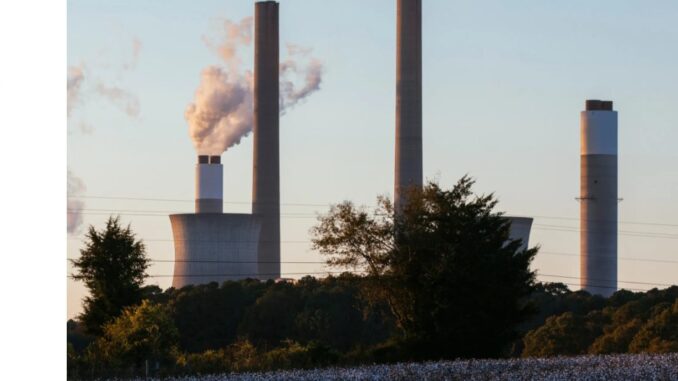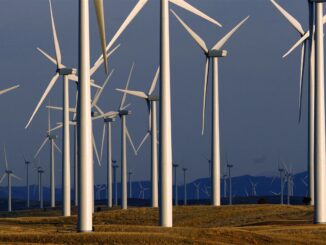
If the regulation is implemented, it will be the first time the federal government has limited carbon emissions from existing power plants, which generate 25 percent of U.S. greenhouse gases.
WASHINGTON — President Biden’s administration is poised to announce limits on greenhouse gas emissions from power plants that could compel them to capture the pollution from their smokestacks, technology now used by fewer than 20 of the nation’s 3,400 coal and gas-fired plants, according to three people who were briefed on the rule.
If implemented, the proposed regulation would be the first time the federal government has restricted carbon dioxide emissions from existing power plants, which generate about 25 percent of the planet-warming pollution produced by the United States. It would also apply to future plants.
Almost all coal and gas-fired power plants would have to cut or capture nearly all of their carbon dioxide emissions by 2040, according to the people familiar with the regulation, who asked not to be identified because the rule has not been made public.
The proposed rule is sure to face opposition from the fossil fuel industry, power plant operators and their allies in Congress. It is likely to draw an immediate legal challenge from a group of Republican attorneys general that has already sued the Biden administration to stop other climate policies. A future administration could also weaken the regulation.
The regulation, proposed by the Environmental Protection Agency, is being reviewed by the White House’s Office of Management and Budget, and could still be adjusted.
Maria Michalos, an E.P.A. spokeswoman, said the agency is “moving urgently to advance standards that protect people and the planet, building on the momentum from President Biden’s Investing in America economic agenda, including proposals to address carbon emissions from new and existing power plants.”
It would not mandate the use of carbon capture equipment, a nascent and expensive technology; rather, it would set caps on pollution rates that plant operators would have to meet. They could do that by using a different technology or, in the case of gas plants, switching to a fuel source like green hydrogen, which does not emit carbon, according to the people familiar with the matter. But the regulation could lead to the broader adoption of carbon capture technology, the people said.
Most of the electricity generated in the United States last year — about 60 percent — came from burning fossil fuels like coal, natural gas and petroleum, according to the U.S. Energy Information Administration.
The proposal comes on the heels of two other Biden administration plans to cut tailpipe emissions dramatically by speeding up the country’s transition to electric vehicles, and curb methane leaks from oil and gas wells.
If those three regulations are implemented as proposed, they would significantly reduce the planet-warming pollution created by the world’s largest economy. Together with the 2022 Inflation Reduction Act, a law that is pouring $370 billion into clean energy programs, they would put the country on track to meet Mr. Biden’s pledge to cut the country’s emissions roughly in half by 2030, and to stop adding carbon dioxide to the atmosphere by 2050.
That is the action required of all major industrialized countries, scientists say, to keep average global temperatures from increasing 1.5 degrees Celsius (2.7 degrees Fahrenheit), compared with preindustrial levels. Beyond that point, the effects of catastrophic heat waves, flooding, drought, crop failure and species extinction would become significantly harder for humanity to handle. The planet has already warmed by an average of 1.1 degrees Celsius.
Mr. Biden has said that he is willing to use his executive authority to act on global warming, a point he has recently stressed after facing sharp criticism from environmentalists, particularly young climate activists, for his decision last month to approve an enormous oil drilling project on pristine land in Alaska, known as Willow.
Image

“We have to do more than recognize the climate challenges we face,” Mr. Biden told other world leaders during a virtual gathering on Thursday to discuss climate and energy. “We are determined to strengthen our ambition and our actions. And, yes, we’re willing to do the hard work to limit global warming to 1.5 degrees Celsius.”
In releasing a climate rule for power plants, Mr. Biden hopes to succeed where his former boss, President Barack Obama, failed. Nearly a decade ago, Mr. Obama tried to enact broad limits on power plant pollution that were first blocked by the Supreme Court and then rolled back by President Donald J. Trump. Last summer, the Supreme Court confirmed that the E.P.A. had the authority to regulate carbon emissions from power plants but in a limited way.
But three factors have emboldened the Biden administration. First, carbon capture technology has advanced since the Obama administration. Second, when Democrats passed the Inflation Reduction Act last year, they added language that classified greenhouse gases as pollutants to be regulated by the E.P.A. Lastly, the new law provides tax credits to power plant operators that capture their carbon, making the technology more financially feasible.
Instead of creating one limit that all power plants must comply with, the E.P.A. intends to be flexible, the people familiar with the new plan said. It plans to set various targets based on the size of the plant, whether it runs regularly or intermittently, and whether it is already scheduled for retirement. Some coal plants that are scheduled to shut down in the next decade may not have to meet the new standards at all.
Patrick Morrisey, the Republican attorney general of West Virginia, a major coal-producing state, said on Friday that he and others were waiting to see Mr. Biden’s plan. “We are eager to review the E.P.A.’s new proposed rule on power plants, and we’ll be ready once again to lead the charge in the fight against federal overreach,” he said in a statement.
Some environmental groups are also critical of carbon capture technology, arguing that it makes more sense to switch to wind, solar and other clean energy sources that don’t pollute in the first place.



